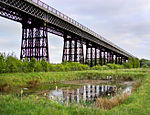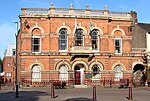Bennerley Viaduct (originally Ilkeston Viaduct and known informally as the Iron Giant) is a former railway bridge, now a foot and cycle bridge, between Ilkeston, Derbyshire, and Awsworth, Nottinghamshire, in central England. It was completed in 1877 and carried the Great Northern Railway's (GNR) Derbyshire Extension over the River Erewash, which forms the county boundary, and its wide, flat valley. The engineer was Samuel Abbott, who worked under Richard Johnson, the GNR's chief engineer. The site required a bespoke design as the ground would not support a traditional masonry viaduct due to extensive coal mining. The viaduct consists of 16 spans of wrought iron, lattice truss girders, carried on 15 wrought iron piers which are not fixed to the ground but are supported by brick and ashlar bases. The viaduct is 60 feet (18 metres) high, 26 feet (8 metres) wide between the parapets, and over a quarter of a mile (400 metres) long. It was once part of a chain of bridges and embankments carrying the railway for around two miles (three kilometres) across the valley but most of its supporting structures were demolished when the line closed in 1968. The only similar surviving bridge in the United Kingdom is Meldon Viaduct in Devon.
The viaduct opened in January 1878. Its working life was uneventful except for minor damage inflicted by a Zeppelin bombing raid during the First World War.
Plans to demolish the viaduct failed because of the cost of dismantling the ironwork and it became a listed building in 1974. After closure, the viaduct received little maintenance and fell into disrepair. Railway Paths, a walking and cycling charity, acquired it for preservation in 2001 but work faltered due to a lack of funding. The viaduct was listed on the Heritage at Risk Register in 2007 and the 2020 World Monuments Watch for its condition and lack of use. A detailed survey was undertaken in 2016 and funding for restoration work was secured in 2019. The work included rebuilding an embankment to allow step-free access. It opened to the public as part of a cycling and walking route in January 2022.







